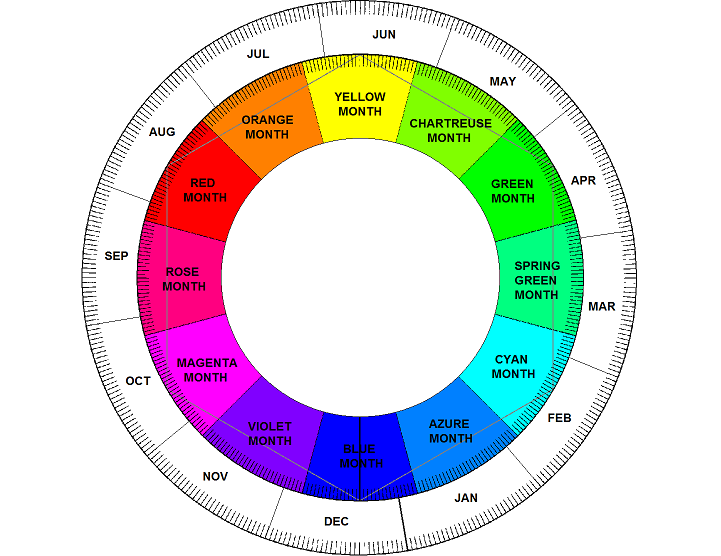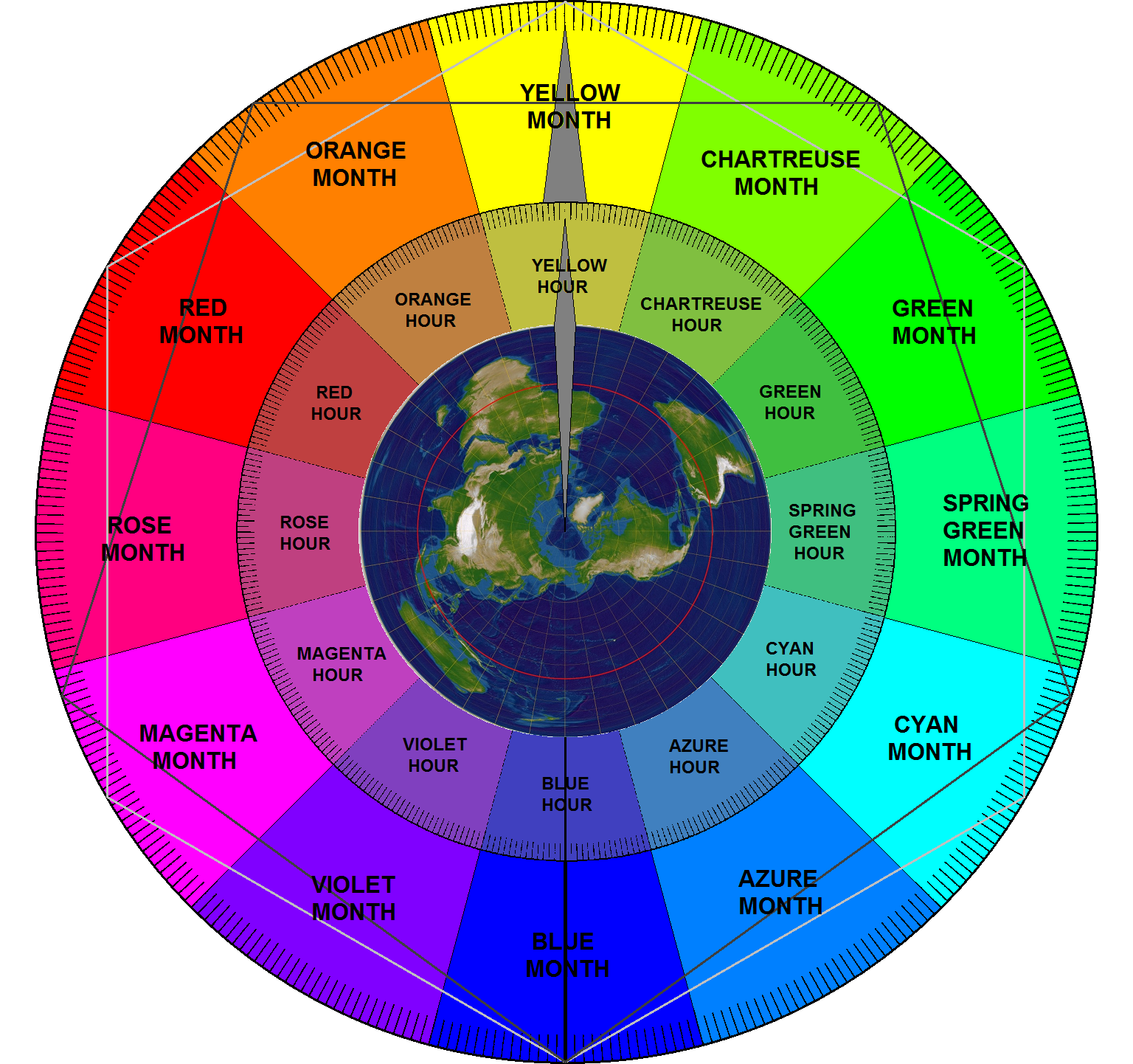
Time Measurement
This page describes the official international standard of time measurement of the Universal Selfederation.
Year Time Measurement
Each year is divided into 12 months, each of which is divided into 30 days. They are named as follows:
- Blue Month
- Azure Month
- Cyan Month
- Spring Green Month
- Green Month
- Chartreuse Month
- Yellow Month
- Orange Month
- Red Month
- Rose Month
- Magenta Month
- Violet Month
The remaining 5 days (6 for the leap years) are called "Grey Days" and are considered holidays; they aren't considered part of any month and are distributed evenly between the other days of the year with an interval of 72 days (60 in the leap years) from each other, according to the following scheme:
- 5th-last Grey Day: between 27° and 28° day of Cyan Month
- 4th-last Grey Day: between 9° and 10° day of Chartreuse Month
- 3rd-last Grey Day: between 21° and 22° day of Orange Month
- 2nd-last Grey Day: between 3° and 4° day of Magenta Month
- Last Grey Day: between 15° and 16° day of Blue Month
(for the leap years instead, the scheme is the following:
- 6th-last Grey Day: between 15° and 16° day of Cyan Month
- 5th-last Grey Day: between 15° and 16° day of Green Month
- 4th-last Grey Day: between 15° and 16° day of Yellow Month
- 3rd-last Grey Day: between 15° and 16° day of Red Month
- 2nd-last Grey Day: between 15° and 16° day of Magenta Month
- Last Grey Day: between 15° and 16° day of Blue Month
this means the Last Grey Day is the only one which always falls on the same day).
The Last Grey Day corresponds to winter solstice (December 21 in the Gregorian Calendar) and is considered the last day of the year. This means the Blue Month is split evenly between 2 consecutive years: the 1st half lies ad the end of a year, while the 2nd half at the beginning of the following one.
The year 0 of the Official Autopian Calendar is the one that starts during 476 A.D., and roughtly corresponds to 477 A.D.
Week days aren't counted (there is no such thing as a "week").
Non-leap year summary:
- Blue Month (second half) = from December 22 to January 5
- Azure Month = from January 6 to February 4
- Cyan Month = from February 5 to March 7 (except March 4, which is a Grey Day)
- Spring Green Month = from March 8 to April 6
- Green Month = from April 7 to May 6
- Chartreuse Month = from May 7 to June 6 (except May 16, which is a Grey Day)
- Yellow Month = from June 7 to July 6
- Orange Month = from July 7 to August 6 (except July 28, which is a Grey Day)
- Red Month = from August 7 to September 5
- Rose Month = from September 6 to October 5
- Magenta Month = from October 6 to November 5 (except October 9, which is a Grey Day)
- Violet Month = from November 6 to December 5
- Blue Month (first half) = from December 6 to December 20 (except December 21, which is a Grey Day)

Comparison between the autopian calendar and the current one;
warning: grey days are hidden under the grey pentagon's vertices
Leap year summary:
- Blue Month (second half) = from December 22 to January 5
- Azure Month = from January 6 to February 4
- Cyan Month = from February 5 to March 6 (except February 20, which is a Grey Day)
- Spring Green Month = from March 7 to April 5
- Green Month = from April 6 to May 6 (except April 21, which is a Grey Day)
- Chartreuse Month = from May 7 to June 5
- Yellow Month = from June 6 to July 6 (except June 21, which is a Grey Day)
- Orange Month = from July 7 to August 5
- Red Month = from August 6 to September 5 (except August 21, which is a Grey Day)
- Rose Month = from September 6 to October 5
- Magenta Month = from October 6 to November 5 (except October 21, which is a Grey Day)
- Violet Month = from November 6 to December 5
- Blue Month (first half) = from December 6 to December 20 (except December 21, which is a Grey Day)

Comparison between the autopian calendar and the current one (for leap years);
warning: grey days are hidden under the grey hexagon's vertices
Day Time Measurement
Each day is divided into 12 hours (therefore autopian hours are 2 times longer than current ones), each of which is divided into 30 minutes (therefore autopian minutes are 4 times longer than current ones). They are named as follows:
- Blue Hour
- Azure Hour
- Cyan Hour
- Spring Green Hour
- Green Hour
- Chartreuse Hour
- Yellow Hour
- Orange Hour
- Red Hour
- Rose Hour
- Magenta Hour
- Violet Hour
The end of the day is midnight, which falls exactly between the 15° and the 16° minute of the Blue Hour. This means that the Blue Hour is split evenly between 2 consecutive days: the 1st half lies ad the end of a day, while the 2nd half at the beginning of the following one.
There is no such thing as a "daylight saving time".
Day summary:
- Blue Hour (last half) = from 00:00 to 01:00
- Azure Hour = from 01:00 to 03:00
- Cyan Hour = from 03:00 to 05:00
- Spring Green Hour = from 05:00 to 07:00
- Green Hour = from 07:00 to 09:00
- Chartreuse Hour = from 09:00 to 11:00
- Yellow Hour = from 11:00 to 13:00
- Orange Hour = from 13:00 to 15:00
- Red Hour = from 15:00 to 17:00
- Rose Hour = from 17:00 to 19:00
- Magenta Hour = from 19:00 to 21:00
- Violet Hour = from 21:00 to 23:00
- Blue Hour (first half) = from 23:00 to 00:00

Comparison between the autopian clock and the current one
Clocklendar
The Clocklendar is a time measurement device that acts simultaneosly as a calendar and as a clock. The outer ring represents all the months and days in a year, and it features a longer counter-clockwise spinning hand pointing at the current day of the year; superimposed on it, the inner ring represents all the hours and minutes in a day; and it features a shorter counter-clockwise spinning hand pointing at the current minute of the day; the shorter hand is tied to an azimuthal projection of the Earth's surface, allowing to simultaneosly know the corresponding hour in other parts of the world too.

Example of a clocklendar during midday of the fourth-last grey day (between the 15° and 16° day of the Yellow Month)
Return